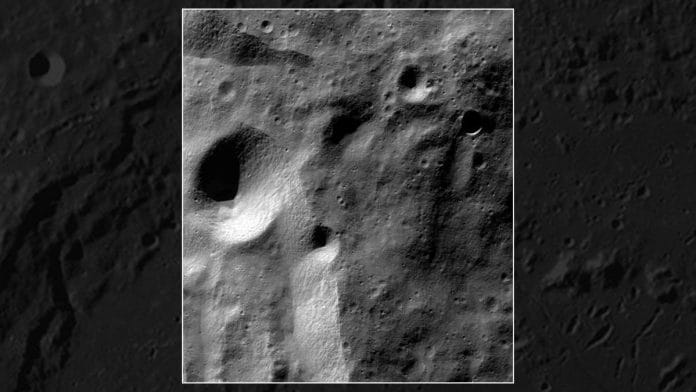Bengaluru: The Imaging Infrared Spectrometer (IIRS) instrument onboard the Chandrayaan-2 lunar orbiter has confirmed the presence of both hydroxyl ions (OH) and water molecules (H2O) on the surface of the moon.
It has further quantified the amount of water molecules present on the lunar surface regions it imaged, and distinguished parts of the moon that are water-rich from those that are scant in hydration.
The findings are the work of teams from the Indian Institute of Remote Sensing (ISRO-Dehradun), Space Applications Centre (ISRO-Ahmedabad), and UR Rao Satellite Centre (ISRO-Bengaluru). The results were published this week in the journal Current Science.
The discovery of hydration on the lunar surface was originally made by the Chandrayaan-1 mission, but the low resolution of its mapper could not quantify between the readings from OH and water molecules.
The new findings were made by a more powerful spectrometer, which analysed three ‘strips’ of the Moon, within the latitude range of 29°N and 62°N, covering a varying set of geological formations.
Increased spectral coverage
The Chandrayaan-1 mission, ISRO’s first lunar orbiter, launched in 2008, was the first to provide results about the possibility of hydration on the Moon. Two instruments from the mission confirmed the presence of water in a span of days.
On 24 September 2009, NASA announced that the M3 instrument had detected water ice on the Moon. A day later, ISRO announced that three months before M3 made its discovery, Moon Impact Probe (MIP) had already detected hydration just before impact, through Chandra’s Altitudinal Composition Explorer (CHACE) instrument.
In November 2008, the MIP payload was released from the orbiter and allowed to fall freely to impact the surface of the lunar South Pole. When it did so, it displaced the top of the lunar soil, the regolith, and exposed the soil below. The CHACE instrument on MIP collected spectral data as it fell.
M3 confirmed and provided evidence of water and water ice in the shadowed regions on the moon as well as both its poles. The instrument, a spectrometer that analysed the amount of radiation reflected back from the Moon’s surface and distinguished signatures of hydration from it, operated in the 2.8-3.0 μm spectral range, which is not very effective at distinguishing between hydroxyl ions and water molecules, and the combination of the two.
The authors of the new Chandrayaan-2 paper state that in order to quantify water molecules more accurately, the new infrared spectrometer IIRS was designed to operate in the 0.8 to 5 μm range.
The IIRS mapped the lunar surface from a circular orbit of 100km from the Moon’s surface. It functions at a resolution of 80 m, covering a width of 20 km in each strip, and has been making observations systematically since September 2019.
Also read: What is the cryogenic upper stage that led to failure of ISRO’s earth observation satellite
Source of water
The data confirmed that hydration was present on sunlit portions, permanently shadowed craters, and polar regions, as previous findings have shown.
The team found that silicate rocks called plagioclase absorbed more water, while older highland rocks that rise above the surface showed weak signatures of hydration. In warmer, lower-latitude mare regions or maria — the large, darkly coloured, basaltic plains, some of which are visible to the naked eye from Earth — there was nearly no water signature.
The authors propose a number of theories for the source of hydration on the moon, including origins from within the Moon’s internal mantle processes of the past. Another likely source could have been water or ice-bearing comets that could have crashed into the Moon millions of years ago, depositing water molecules.
The findings of water within olivine melt inclusions or small crystallised bits of magma on the Moon also back this origin, say the authors.
However, they state that the most likely and widespread source of water is the interaction of the solar wind or charged solar particles with the surface of the Moon, in the absence of a protective atmosphere or magnetic field. This process is called space weathering, and similar to weathering processes on Earth, there are weathering effects on atmosphere-less bodies exposed to the vacuum of space.
Space weathering can occur not just from the solar wind but also from meteors and meteorites, comets, cosmic rays, and more. It can also alter reflection and spectral readings and the optical properties of surfaces, sometimes resulting in incorrectly interpreted data.
The authors propose that by the process of space weathering, the lunar regolith that is rich in silicates and oxides are bombarded at high speeds of up to 800 mps by charged particles like protons and electrons from the sun. This causes chemical and structural changes in the composition of the soil at impact, trapping a proton from the solar wind and causing hydrogen to bond with oxygen to eventually form water.
The scientists state that once these molecules are formed, they get distributed across the surface by variations in temperature between the day and night time on the Moon and that higher daytime temperatures break OH bonds leading to a lack of hydration signature.
Data collection from the IIRS instrument is ongoing and more data is expected soon.
(Edited by Paramita Ghosh)
Also read: How this IIT-Madras grad is pushing battery tech in US that could power passenger planes






